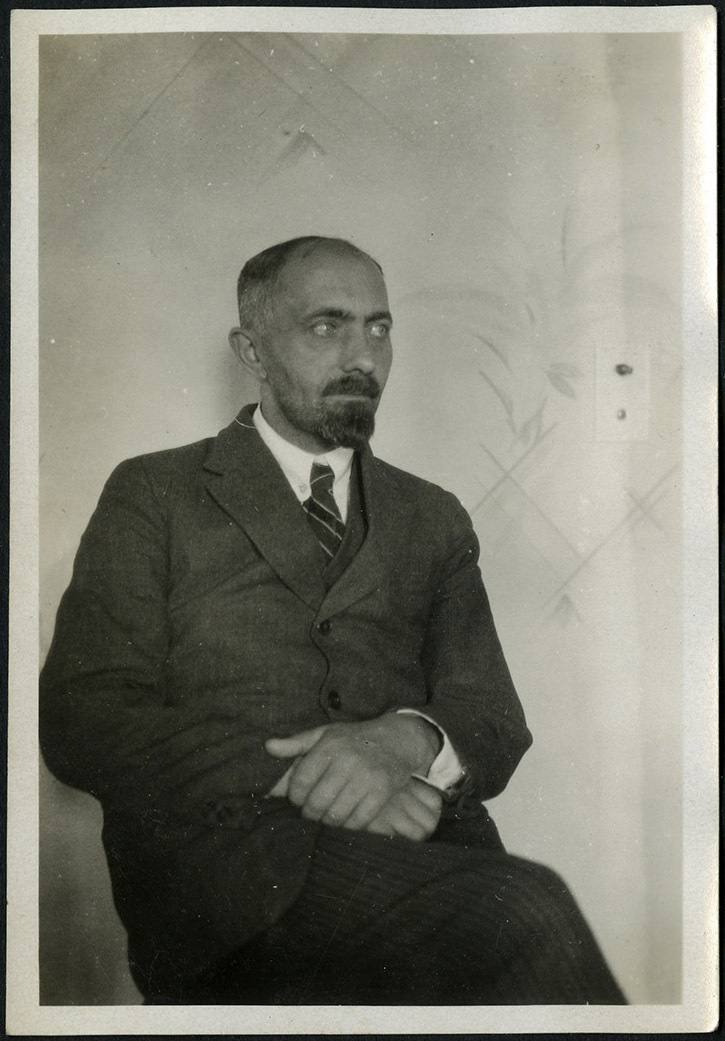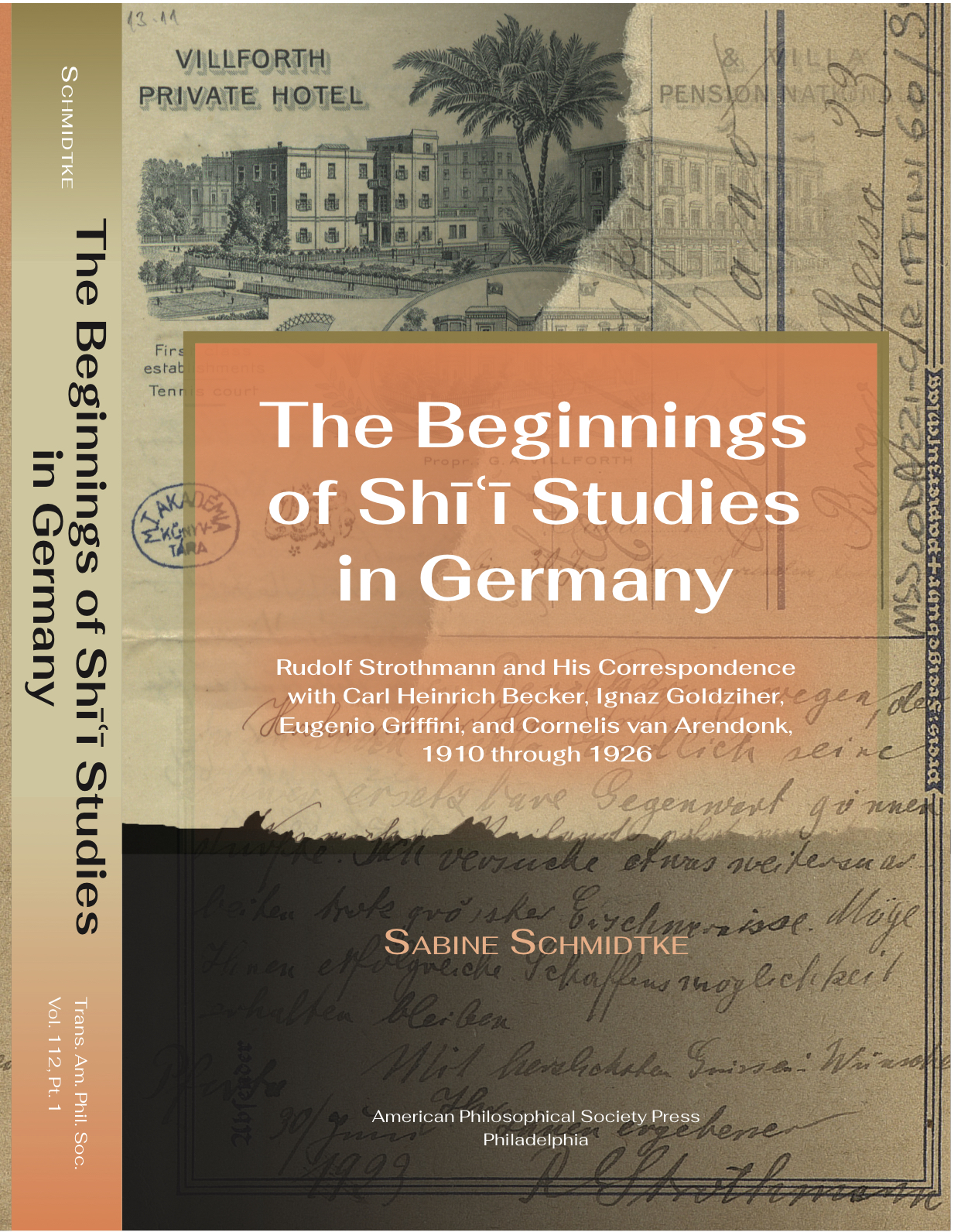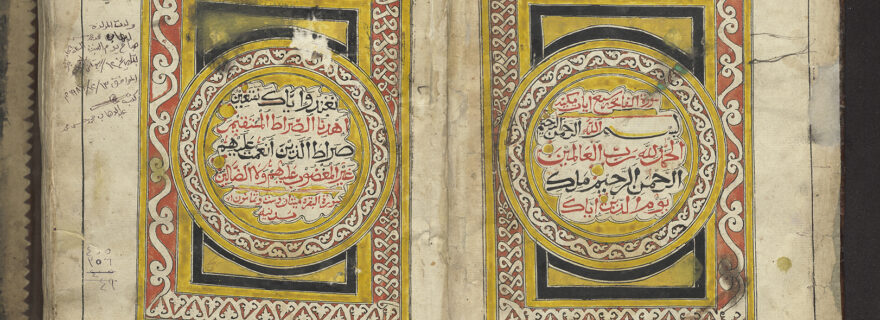Rudolf Strothmann and the Beginnings of Zaydi Studies in Germany
Rudolf Strothmann (1877–1960) played a pioneering role in the scholarly exploration of Shīʿī Islam in Western, and in particular German, scholarship. Between 1910 and 1923, he published several pathbreaking studies on the Zaydiyya, consulting primarily the recently purchased collections of Yemeni Zaydī manuscripts in Berlin. At the same time, and to the extent that this was possible in view of the lack of relevant sources in Germany and the rest of Europe, Strothmann began to delve into Twelver Shīʿī literature, an endeavor which culminated in his 1926 monograph, Die Zwölfer-Schīʿa: Zwei religionsgeschichtliche Charakterbilder aus der Mongolenzeit, a portrait of the two prominent thirteenth-century Imāmī scholars Naṣīr al-Dīn al-Ṭūsī (d. 672 AH [1274]) and Raḍī al-Dīn ʿAlī b. Mūsā Ibn Ṭāwūs (d. 664 AH [1266]). During the later decades of his life, Strothmann primarily focused on various strands of Ismāʿīlism. His rich published work testifies to his erudition and versatility and continues to form an important point of departure for scholars working on different aspects of Shīʿism in the early twenty-first century.

The Early Years
Heinrich Friedrich Rudolf Strothmann was born on 4 September 1877 in Lengerich, in North Rhine-Westphalia, into a Lutheran family, as the sixth of eight children of Johann Heinrich Strothmann (1839–1917), a tenant farmer, and Marie Elisabeth Strothmann (née Stapenhorst, 1843–1884). Like his older brother Wilhelm (1873–1942), Rudolf Strothmann decided to embark on a career as a theologian. He studied theology first at the University of Halle-Wittenberg (winter 1897/98–summer 1899), then at Bonn (academic year 1899/1900). In addition, he began to delve into Syriac studies, attending some of the courses given by Eugen Prym (1843–1913). Strothmann’s engagement with both Syriac and Hebrew must have been continuous and intensive, as he became an accomplished Hebraist and Syriacist. Strothmann spent the academic year 1901/2 at the Predigerseminar zu Soest, and in the autumn of 1902 he moved to Münster, where he served as a teacher of religion in various high schools of Münster. From 1 October 1907 until 1923, Strothmann filled the double position of a senior teacher and a deacon at the prestigious boarding school of Schulpforta in Saxony-Anhalt. From the winter term of 1923/24 until the summer term of 1927, Strothmann taught at Gießen University, as successor of Paul E. Kahle (1875–1964). In 1927, Strothmann was appointed to Hamburg University and he held the chair in Semitic languages and literatures for two decades, until his retirement in 1947.
Carl Brockelmann and Zaydī Studies
On various occasions, Rudolf Strothmann related that it was Carl Brockelmann (1868–1956), who enticed him toward Arabic and Islamic matters. Brockelmann taught at Königsberg between since 1903 until obtaining an appointment at the University of Halle-Wittenberg in 1910. The two had met by pure chance in Warnemünde, a seaside resort on the Baltic Sea near Rostock, possibly in 1903 or 1904. At some point, Brockelmann steered Strothmann’s attention toward Zaydī Shīʿism and the impressive collection(s) of Zaydī/Yemeni manuscripts that had recently arrived in Europe. This corpus included the manuscript collections that had been brought together by Eduard Glaser (1855–1908) and sold to libraries in Berlin (1884 and 1887), London (1889), and Vienna (1895), as well as those collected by Giuseppe Caprotti (1862–1919), which were purchased in 1902 by the Bavarian State Library and by the Biblioteca Ambrosiana in Milan (1909 and 1914). A sizeable collection of manuscripts of Yemeni provenance, which had been brought to the Netherlands in 1883 by the Medinan scholar and book dealer Amīn b. Ḥasan al-Ḥulwānī al-Madanī (d. 1316 AH [1898]), was acquired by E. J. Brill and subsequently sold to the library of Leiden University, whereas another al-Madanī collection of 1,052 manuscripts containing numerous codices of Yemeni provenance (the Landberg collection) was purchased in 1884 by the Royal Library in Berlin.
Yemeni Manuscripts in Berlin, Leiden, and London
The Berlin Glaser collection was Strothmann’s principal point of departure. His first visit to the Königliche Bibliothek took place in October 1908, when he spent some weeks consulting manuscripts in the library. Over the following years, Strothmann spent most of his vacation time in Berlin, working on the manuscripts. From early on, Strothmann was also aware of the holdings of manuscripts from Yemen in Leiden and London. Through Carlo Landberg’s (1848–1924) Catalogue de manuscripts arabes provenant d’une bibliothèque privée à el-Medîna et appartenant à la maison E. J. Brill, published in 1883, Strothmann knew about the relevant codices in Leiden, and Leiden University Library had sent him two biographical works concerned with the Zaydī imāms before 1910, namely, Ms. Leiden, Or. 2616.1, a copy of Imām al-Nāṭiq bi-l-Ḥaqq Abū Ṭālib Yaḥyā b. al-Ḥusayn al-Hārūnī’s (d. 424 AH [1033]) al-Ifāda fī tārīkh al-a’imma al-sāda, which he had received in 1907 and which he had transcribed for himself with the intention of eventually publishing the text, and Ms. Leiden, Or. 2626, a partial copy of al-Ḥumayd al-Muḥallī’s (d. 652 AH [1254]) biographical work dedicated to the lives of the imāms, al-Ḥadāʾiq al-wardiyya fī dhikr aʾimmat al-Zaydiyya. Thanks to Charles Rieu’s (1820–1902) catalogue of the London collection, which was published in 1894, Strothmann was also informed about the British Museum’s holdings of Yemeni manuscripts, some of which he was able to consult through photograms of individual folios that were prepared for him by the library. It was Carl Heinrich Becker (1876–1933) who first drew Strothmann’s attention to the Caprotti collection of Zaydī manuscripts in Munich. Moreover, Strothmann was aware of Emil Gratzl’s (1877–1957) 1910 exhibition catalogue, Katalog der Ausstellung von Handschriften aus dem islamischen Kulturkreis im Fürstensaal des K. Hof- und Staatsbibliothek, which includes information on some of the Yemeni manuscripts in Munich. No systematic catalogue was available for the Munich collection when Strothmann began to work on Zaydism, although Emil Gratzl, together with Eduard Glaser, who had settled in Munich in 1891, had embarked on the preparation of a catalogue of the Munich manuscripts from Yemen. Although this never materialized, Gratzl and his colleagues were forthcoming in answering Strothmann’s inquiries and requests, and they had selected codices dispatched by mail to Strothmann through the library of the Landesschule Pforta.

Eugenio Griffini and the Caprotti Collection in Milan
In 1908 Eugenio Griffini (1878–1925) started to publish a partial catalogue of the Caprotti collection of Yemeni manuscripts in Milan, and it appeared over the next decade in instalments in the Rivista degli studi orientali. Between 1903 and 1906, Caprotti sent the manuscripts to Griffini’s apartment in via Dante in Milan, where they were kept until the end of 1908, when Griffini moved to via Borgospesso 23. Griffini was unable to house the collection in his new home, and it is likely that the manuscripts spent some time in Caprotti’s residence in Magenta before arriving at the Ambrosiana between November 1909 and January 1910. Brockelmann had been corresponding with Griffini since 1907, and in the early summer of 1910 the latter had sent him the first instalment of his “Lista dei manoscritti arabi, nuovo fondo della Biblioteca Ambrosiana di Milano.” Although it can be assumed that Strothmann knew about the Milan collection through Brockelmann, Emil Gratzl also drew Strothmann’s attention to the collection of Yemeni manuscripts in Milan. Much of the information Strothmann had about the collection and about individual codices, including excerpts from some of them, was provided to him by Griffini through direct correspondence. In his two 1912 monographs, Das Staatsrecht der Zaiditen and Der Kultus der Zaiditen, Strothmann refers to Mss. Ambrosiana, Nuovo Fondo, ar. A 55 and B 83, two witnesses of the Kitāb al-Maṣābīḥ by Abū l-ʿAbbās Aḥmad b. Ibrāhīm al-Ḥasanī (fl. first half of the fourth AH [tenth] century), a biographical work dedicated to the lives of the imāms; Ms. Ambrosiana, Nuovo Fondo, ar. A 58, a partial copy of Aḥmad b. Yaḥyā Ibn al-Murtaḍā’s al-Baḥr al-zakhkhār; Ms. Ambrosiana, Nuovo Fondo, ar. C 63, containing Ibn al-Murtaḍā’s Iḥkām fī sharḥ Takmilat al-aḥkām; Mss. Ambrosiana, Nuovo Fondo, ar. D 223–225 and E 262, containing different volumes of Muḥammad b. Yaʿqūb al-Hawsamī’s commentary on the Ibāna; and Ms. Ambrosiana, Nuovo Fondo, ar. E 413/I, containing the Majmūʿ of Imām al-Hādī ilā l-Ḥaqq Yaḥyā b. al-Ḥusayn (d. 298 AH [911]), the founder of the Zaydī state in Yemen. It was only toward the end of December 1912 that Strothmann was able to visit Milan and inspect some of the manuscripts in person, notably, Mss. Ambrosiana, Nuovo Fondo, ar. E239/II and ar. G 11, containing a copy of Majmūʿ al-fiqh attributed to the eponymous founder of the Zaydiyya, Zayd b. ʿAlī (d. 122 AH [740]). A few years later, through Griffini’s 1915 publication “Die jüngste ambrosianische Sammlung arabischer Handschriften,” Strothmann learned about Ms. Ambrosiana Nuovo Fondo, ar. H 135, containing the Amālī of Imām ʿAbd Allāh Aḥmad b. ʿĪsā b. Zayd al-Ḥusaynī (b. 157 AH [773], d. 247 AH [861]) in the recension of Muḥammad b. Manṣūr b. Yazīd al-Murādī (alive in 252 AH [866]), a crucial source in his view for the reconstruction of the development of fiqh among the early Zaydīs. For his 1923 publication “Das Problem der literarischen Persönlichkeit Zaid b. ʿAlī,” Strothmann could rely on Griffini’s 1919 edition of the Majmūʿ, which was based on all witnesses of the Majmūʿ in the Ambrosiana, and its regular references to the Amālī of Aḥmad b. ʿĪsā.
It was apparently also Griffini’s 1915 publication that aroused Strothmann’s interest in the Ismāʿīlī materials among the Caprotti manuscripts that were given to the Ambrosiana in May 1914. One of the codices described by Griffini (Ms. Milan, Ambrosiana, Nuovo Fondo, ar. H 75) was the subject of Strothmann’s 1943 publication Gnosis-Texte der Ismailiten, followed by his Ismailitischer Koran-Kommentar, an edition of Mizāj al-tasnīm by Ḍiyāʾ al-Dīn Ismāʿīl b. Hibat Allāh al-Ismāʿīlī al-Sulaymānī (d. 1184 AH [1770]) on the basis of Ms. Milan, Ambrosiana, Nuovo Fondo, ar. H 76. This codex, the only extant witness of the work, was also described by Griffini in 1915. Strothmann submitted the edition to the Akademie der Wissenschaften in Göttingen in June 1943, and it was published in four installments between 1944 and 1955.
The Vienna Glaser Collection
Although Strothmann was aware of the Glaser collection of Yemeni manuscripts in Vienna, accessing this material proved very challenging—all Strothmann was initially able to rely on was Max Grünert’s (1849–1929) brief assessment of the Vienna Glaser collection that had been published in 1897, and the librarians of Vienna were less forthcoming in responding to Strothmann’s inquiries (and possibly less able to do so) than those of Munich, Leiden, London, and Milan had been. Eventually, however, Strothmann gained access to Grünert’s handwritten catalogue (as well as an index of authors and titles that had been prepared by the librarians on the basis of Grünert’s handlist) and at some point traveled to Vienna to consult some of the Vienna Glaser manuscripts in person.
Political Doctrines, Civil Law, and Religious Practices of the Zaydīs
The first fruit of Strothmann’s endeavor was an extensive historio-bibliographical overview article on Zaydī Shīʿism, “Die Literatur der Zaiditen,” which was published in two installments in the journal Der Islam, in 1910 and 1911. His overall aim was to study three main aspects of Zaydism, namely, (1) political doctrines and history (“Staatsrecht”), (2) civil law (“Bürgerliches Recht”), and (3) the history of religious practices (“Kultus”) in order to situate the Zaydiyya between (mainstream) Sunnism on the one hand, and Imāmī or Twelver Shīʿism on the other. Strothmann had completed drafts of all three parts of his study when he approached Carl Heinrich Becker on 1 July 1910 on Brockelmann’s recommendation, asking about the possibility of publishing “Die Literatur der Zaiditen” in Der Islam and proposing that it be followed by three (or more) installments containing the remaining parts of his study on Zaydism, in the aforementioned sequence. However, when Strothmann was contacted by Cornelis van Arendonk (1881–1945), who had started to work on the history of Zaydism within the framework of his doctoral dissertation under the guidance of Christiaan Snouck Hurgronje (1857–1936), Strothmann began to find ways to publish the results of his research faster than would have been possible in Der Islam. Moreover, he omitted a portion he had written about the history of Zaydism, as he had agreed with Snouck Hurgronje and van Arendonk that this topic would be covered in the latter’s dissertation.
On 1 March 1911 Strothmann submitted to Halle-Wittenberg University his doctoral dissertation, “Das Staatsrecht der Zaiditen, Kap. 1–3, 3 1,” which he had prepared under the supervision of Carl Brockelmann. On 24 April 1911 Brockelmann presented a favorable report on the dissertation to the dean of the university’s faculty of philosophy, Philipp Strauch (1852–1934), and on 22 May 1911, Strothmann successfully passed his PhD exam (magna cum laude). In 1912, Strothmann published Das Staatsrecht der Zaiditen, containing his 1911 doctoral dissertation (pp. 1–47) and a completion of the study (pp. 47–109), as the first volume in the newly established supplementary series to Der Islam, edited by Carl Heinrich Becker and titled “Studien zur Geschichte und Kultur des islamischen Orients.” In the same year, he published the third part of his study on Zaydism, Der Kultus der Zaiditen, as a supplement to the Jahresbericht der Königlichen Landesschule Pforta of 21 May 1912. The second part of his study, “Das Bürgerliche Recht der Zaiditen,” was never published. On 14 March 1911, Strothmann wrote to Griffini that he had essentially completed the study and that it had been accepted for publication in the Mittheilungen des Seminars für Orientalische Sprachen, the journal published by the Seminar für Orientalische Sprachen at the Königliche Friedrich-Wilhelms-Universität zu Berlin and founded in 1887 under the direction of Eduard Sachau (1845–1930). Strothmann hesitated, however, to go ahead with the finalization and publication of the study since he had not yet seen the Majmūʿ al-fiqh attributed to Zayd b. ʿAlī, which, he assumed, would be indispensable to complete the study. Eager to avoid any conflict with Griffini, who already worked on the Majmūʿ, Strothmann even offered to him in a letter of 14 March 1911 to let go of the project. Moreover, Strothmann’s inquiry a few months later, in a letter dated 19 June 1911, as to whether he might spend his summer vacation of 1911 in Milan to consult the Majmūʿ in the Ambrosiana Library was turned down by Griffini.
After his visit to the Ambrosiana in December 1912, Strothmann continued to work on “Das Bürgerliche Recht der Zaiditen,” although his goals for the project had apparently changed. The outbreak of World War I may have been another factor that slowed down his progress. After the end of World War I, when Strothmann was able to resume his scholarly work, his plans had apparently shifted in more than one way. Nonetheless, in a letter to Griffini on 15 January 1920, Strothmann again mentioned the study, apparently still resolved to publish it. What ultimately prevented Strothmann from publishing the last part of his study on Zaydism is unclear. Griffini’s edition of the Majmūʿ had been published by this time, so it is unlikely that he opposed Strothmann’s plans in any way. It is possible that the project was thwarted by the overall poor economic situation during the 1920s. Some of the material Strothmann had gathered for the third volume was integrated into his final major study on Zaydism, his 1923 “Das Problem der literarischen Persönlichkeit Zaid b. ʿAlī,” which also contained his detailed argumentation as to why the Majmūʿ al-fiqh attributed to Zayd b. ʿAlī could not possibly be authentic—contra Griffini, who considered the work authentic.
For a full study of Strothmann’s life and scholarly trajectory, with emphasis on the first three decades of the twentieth century, see Sabine Schmidtke, The Beginnings of Shīʿī Studies in Germany: Rudolf Strothmann and His Correspondences with Carl Heinrich Becker, Ignaz Goldziher, Eugenio Griffini, and Cornelis van Arendonk, 1910 through 1926 (Philadelphia: American Philosophical Society Press, 2023).

This blog entry is part of the Zaydi Studies Series commissioned and edited by Ekaterina (Kate) Pukhovaia, Leiden University.


